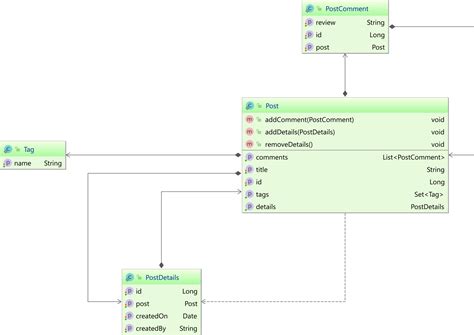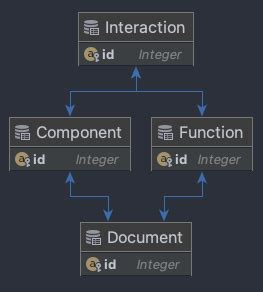spring boot jpa clone entity | clone jpa entity spring boot jpa clone entity Learn the best way to clone or duplicate an entity with JPA and Hibernate. By using a copy constructor you can chose the attributes that need to be cloned. This is an authentic LOUIS VUITTON Damier Azur Croisette. This compact tote is crafted of Louis Vuitton Damier coated canvas in blue and white. The bag features signature vachetta cowhide leather trim including a strong and sturdy top handle with a removable tassel, and an optional shoulder strap with brass hardware.
0 · hibernate jpa clone
1 · cloning jpa in java
2 · clone jpa entity
Starpsezonu izpārdošana ir klāt! Iepērcieties tiešsaistē un ietaupi līdz -50%! Apģērbu izpārdošana ️ bit.ly/2WwyPBK Aksesuāru izpārdošana ️ bit.ly/2QNv1bV
hibernate jpa clone
The simplest approach to clone an entity is to manually copy its fields. We can either use a constructor or a method that explicitly sets each field value. This gives us full control .In this tutorial, we’ll learn about the basics of entities, along with various . I have a JPA entity already persisted in the database. I would like to have a copy of it (with a different id), with some fields modified. What is the easiest way to do this? Like: .
Learn the best way to clone or duplicate an entity with JPA and Hibernate. By using a copy constructor you can chose the attributes that need to be cloned.
In the deep copy approach, we make sure that all the objects in the tree are deeply copied, so the copy isn’t dependant on any earlier existing object that might ever change. In .
In this tutorial, we’ll learn about the basics of entities, along with various annotations that define and customize an entity in JPA. 2. Entity. Entities in JPA are nothing .To generate entities from an existing database, use the JPA Structure tab: Click on the + button in JPA Structure. Choose JPA Entities from DB. Choose the public schema as your DB connection to see your tables, then tick the post . JPA, coupled with the power of Spring Boot, empowers developers to streamline database operations and create highly functional applications. This guide delves into essential best practices.
To skip the basics, do the following: Download and unzip the source repository for this guide, or clone it using Git: git clone https://github.com/spring-guides/gs-accessing-data-jpa.git. cd into .
Overview of JPA and Spring Boot. Java Persistence API (JPA) is a standard specification for object-relational mapping (ORM) in Java. It simplifies data persistence in . For Free, Demo classes Call: 020-71173125. Registration Link: Java Classes in Pune! Example: Step 1: To start using Spring Data JPA, we have to include the necessary .
The simplest approach to clone an entity is to manually copy its fields. We can either use a constructor or a method that explicitly sets each field value. This gives us full control over what is copied and how relationships are handled. Let’s create the Product entity and Category entity classes: @Entity public class Category { private Long id; I have a JPA entity already persisted in the database. I would like to have a copy of it (with a different id), with some fields modified. What is the easiest way to do this? Like: setting it's @Id Learn the best way to clone or duplicate an entity with JPA and Hibernate. By using a copy constructor you can chose the attributes that need to be cloned. In the deep copy approach, we make sure that all the objects in the tree are deeply copied, so the copy isn’t dependant on any earlier existing object that might ever change. In this tutorial, we’ll compare these two approaches, and learn four methods to implement the deep copy.
Best way is to just create a new Entity from scratch and feed it the data fields from the original Entity minus the @Id field. You could do this using a copy constructor for example (I know, it's a dirty word in Java). I want copy entity from another entity (copy) for save to DB. BeanUtils.copyProperties(profile, newProfile); if I copy with Id, then the original entity will update, not a new one. java. spring-boot.

cloning jpa in java
In this tutorial, we’ll learn about the basics of entities, along with various annotations that define and customize an entity in JPA. 2. Entity. Entities in JPA are nothing but POJOs representing data that can be persisted in the database. An entity represents a table stored in a database.To generate entities from an existing database, use the JPA Structure tab: Click on the + button in JPA Structure. Choose JPA Entities from DB. Choose the public schema as your DB connection to see your tables, then tick the post table. JPA Buddy suggests attribute types based on your table’s column definition. JPA, coupled with the power of Spring Boot, empowers developers to streamline database operations and create highly functional applications. This guide delves into essential best practices.To skip the basics, do the following: Download and unzip the source repository for this guide, or clone it using Git: git clone https://github.com/spring-guides/gs-accessing-data-jpa.git. cd into gs-accessing-data-jpa/initial. Jump ahead to Define a Simple Entity.
The simplest approach to clone an entity is to manually copy its fields. We can either use a constructor or a method that explicitly sets each field value. This gives us full control over what is copied and how relationships are handled. Let’s create the Product entity and Category entity classes: @Entity public class Category { private Long id;
I have a JPA entity already persisted in the database. I would like to have a copy of it (with a different id), with some fields modified. What is the easiest way to do this? Like: setting it's @Id Learn the best way to clone or duplicate an entity with JPA and Hibernate. By using a copy constructor you can chose the attributes that need to be cloned. In the deep copy approach, we make sure that all the objects in the tree are deeply copied, so the copy isn’t dependant on any earlier existing object that might ever change. In this tutorial, we’ll compare these two approaches, and learn four methods to implement the deep copy. Best way is to just create a new Entity from scratch and feed it the data fields from the original Entity minus the @Id field. You could do this using a copy constructor for example (I know, it's a dirty word in Java).
I want copy entity from another entity (copy) for save to DB. BeanUtils.copyProperties(profile, newProfile); if I copy with Id, then the original entity will update, not a new one. java. spring-boot. In this tutorial, we’ll learn about the basics of entities, along with various annotations that define and customize an entity in JPA. 2. Entity. Entities in JPA are nothing but POJOs representing data that can be persisted in the database. An entity represents a table stored in a database.
To generate entities from an existing database, use the JPA Structure tab: Click on the + button in JPA Structure. Choose JPA Entities from DB. Choose the public schema as your DB connection to see your tables, then tick the post table. JPA Buddy suggests attribute types based on your table’s column definition. JPA, coupled with the power of Spring Boot, empowers developers to streamline database operations and create highly functional applications. This guide delves into essential best practices.

THE CRYPTO DAILY DOUBLE UP | Slots.lv. CLAIM NOW. Boost your bankroll with The Daily Double Up! Make a deposit and claim a 100% match bonus up to $100 once a day! For an even bigger boost, deposit with Bitcoin and get 150% up to $500 instead – redeemable 2X per day! That's on top of the whopping $3,000 Bitcoin Welcome Bonus .
spring boot jpa clone entity|clone jpa entity



























